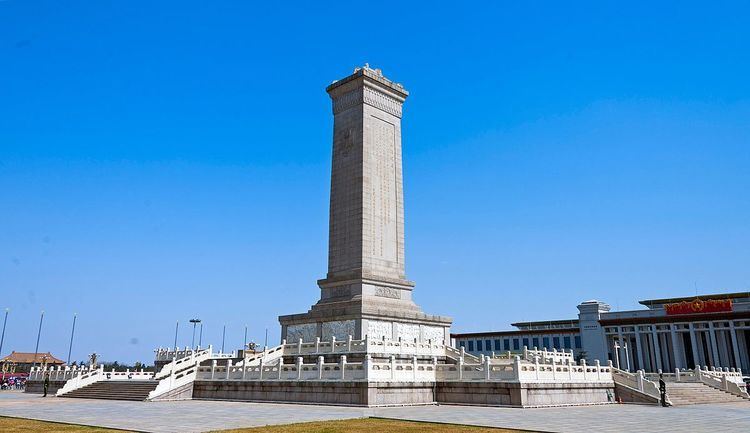Opened May 1958 Beginning date August 1952 | Height 38 m Completion date May 1958 | |
 | ||
Similar Tiananmen Square, Tiananmen, Zhengyangmen, Great Hall of the People, Mausoleum of Mao Zedong | ||
Monument to the people s heroes
The Monument to the People's Heroes (Chinese: 人民英雄纪念碑; pinyin: Rénmín Yīngxióng Jìniànbēi) is a ten-story obelisk that was erected as a national monument of the People's Republic of China to the martyrs of revolutionary struggle during the 19th and 20th centuries. It is located in the southern part of Tiananmen Square in Beijing, to the north of Mausoleum of Mao Zedong. The monument was built in accordance with a resolution of the First Plenary Session of the Chinese People's Political Consultative Conference adopted on November 30, 1949, with construction lasting from August 1952 to May 1958. The architect of the monument was Liang Sicheng, with some elements designed by his wife, Lin Huiyin. The civil engineer, Chen Zhide (陈志德) was also instrumental in realising the final product.
Contents
The monument has also served as the centre of large-scale mourning activities that later developed into protest and unrest, such as the deaths of Premier Zhou Enlai (which developed into the Tiananmen Square protests of 1976) and Hu Yaobang (which developed into the Tiananmen Square protests of 1989).
Description
The monument has an estimated height of 37.94 metres (124.5 ft) and covers an area of 3,000 square metres (32,000 sq ft). It weighs over 10,000 tonnes (9,800 long tons; 11,000 short tons) and contains about 17,000 pieces of marble and granite from Qingdao, Shandong Province, and the nearby Fangshan District.
On the pedestal of the tablet are huge bas-reliefs depicting eight major revolutionary episodes, which can be read in chronological order in a clockwise direction from the east:
- Destruction of opium at Humen (1839), in the run-up to the First Opium War
- Jintian Uprising, the catalyst for the Taiping Revolution (1851)
- Wuchang Uprising, the catalyst for the Xinhai Revolution (1911)
- May 4th Movement (1919)
- May 30 Movement (1925)
- Nanchang Uprising (1927)
- War of Resistance Against Japan (1931-1945)
- Crossing the Yangtze River Campaign in the Chinese Civil War (1949)
On the front of the monument is an inscription in Mao Zedong's handwriting, which reads, "Eternal glory to the people's heroes!" (Chinese: 人民英雄永垂不朽; pinyin: Rénmín yīngxióng yǒngchuí bùxiǔ).
On the back of the monument is an epitaph, composed by Mao Zedong and written by Zhou Enlai:
Commemoration
The conduct of commemoration activities at the Monument to the People's Heroes is regulated by the Major Events Administration Office of the Tiananmen Area Administrative Committee. Strict rules apply to conduct within the vicinity of the monument. Since the protests of 1989 (during which the Monument was a rallying point for the protestors), the government has prohibited climbing the monument beyond the protective barrier without prior approval, as well as photography and filming. Today, those intending to lay wreaths at the monument must apply five days in advance.
Since 1980, it has been customary for visiting foreign dignitaries, especially from historical allies of the People's Republic of China, such as post-Soviet states, to lay wreaths at the monument when visiting Beijing. Certain domestic groups, such as police and military units, would also sometimes lay wreaths at the monument.
